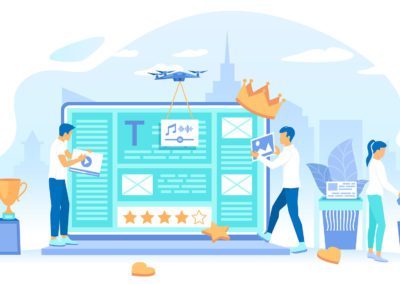Infographics are a powerful tool for conveying complex information in an easy-to-understand way. Visual communication is more effective than written communication, and infographics have become popular because they are an excellent way to communicate data in a visual format. They can be used to illustrate a concept, provide a timeline of events, or explain a process.
Infographics can also be used to explain complex topics such as economics, politics, and science. By combining visuals with text, they make complex information easier to digest and remember. Additionally, they can be used to increase brand awareness and engagement by providing interesting content that people will want to share on social media.
The goal of any infographic should be to communicate information quickly and effectively while still being aesthetically pleasing. In order to do this, there are several things that need to be taken into consideration when creating an infographic: structure, design elements, voice & tone, and promotion.
In this article we will discuss the different aspects of creating an effective infographic: structure, design elements, voice & tone, and promotion. We will look at how each element impacts the overall success of your infographic and provide tips on how you can create an effective infographic that resonates with your audience.
Infographic Structure
Infographics are an effective way to communicate complex information in a visually appealing and easily digestible manner. When creating an infographic, it is important to consider the structure of the content, the visuals used, the design elements, and how it will be promoted.
Types of Infographics
The type of infographic you create should depend on what information you want to convey. Common types of infographics include timeline infographics, comparison infographics, process infographics, statistical infographics, geographic infographics, hierarchical infographics and informational infographics. Each type has different objectives and should be used accordingly.
Data & Visuals
The data and visuals used in the infographic should be relevant and engaging. The data should be accurate and up-to-date. It is also important to ensure that the visuals chosen are appropriate for the topic being discussed and that they do not overpower or distract from the message being conveyed. Additionally, it is important to keep in mind that too much visual clutter can make an infographic difficult to read.
Design Elements
Once you have determined what type of infographic you will create and gathered your data and visuals, it is time to consider design elements such as color scheme, fonts & styles, voice & tone etc. A good color scheme can help to draw attention to key points within your infographic while fonts & styles can help convey a certain tone or mood. Additionally, using a consistent voice throughout your infographic will help ensure that your message is clear and easy to understand.
Design Elements
Infographics are a great way to share information in an attractive and easy-to-understand format. To ensure your infographic is successful, it’s important to pay attention to the design elements involved.
Color Scheme
A well-thought out color scheme can make or break an infographic. It should be used to draw attention to key elements and create a visually appealing piece of content. When selecting colors, consider the message you want to convey, the tone of your content, and how the colors will work together. It’s also important to keep in mind that certain colors have different connotations across cultures, so choose wisely.
Fonts & Styles
The fonts and styles you use in your infographic should be consistent with your brand identity. Make sure they are legible and easy to read at any size. Consider using two different fonts – one for headings and one for body text – to create visual interest and make it easier for readers to scan the content quickly.
Voice & Tone
Your infographic should have a consistent voice and tone throughout. Use language that is clear and concise, but still engaging enough to capture the reader’s attention. Avoid jargon or technical terms unless absolutely necessary as this can confuse readers who may not be familiar with the topic.
Promotion
Infographics are a great way to communicate complex information in an easy-to-understand format. They can be used to promote products, services, or ideas, and they can also be used to educate people about the topics you care about. However, creating an effective infographic requires more than just good design; it also requires effective promotion. Here are some tips for promoting your infographic.
Your Website
The first step in promoting your infographic is to post it on your website. This will give you a platform to showcase the infographic and let people know that it exists. You can also use this platform to link to other websites that have featured or shared the infographic. Additionally, make sure that your website is optimized for search engines so that people can easily find the infographic when searching for related topics.
Joint Infographics
Another great way to promote your infographic is by partnering with other organizations or businesses who have similar interests and goals as you do. For example, if you’re creating an infographic about the importance of recycling, you could partner with a local recycling organization or a business that specializes in sustainable products. By working together, both parties can benefit from the increased exposure and reach of the joint effort.
Social Media
Social media is one of the most powerful tools available for promoting infographics. You can use social media platforms like Twitter, Facebook, Instagram, and LinkedIn to share your infographic with a wide audience and engage with potential customers or followers who may be interested in learning more about the topic at hand. Additionally, consider using paid advertising on social media platforms such as Facebook Ads or Google Ads to reach even more people.
Press Releases
Press releases are another great way to promote infographics and get them in front of a wider audience. Send out press releases through online distribution networks like PR Newswire or Business Wire, as well as through local news outlets if applicable. Make sure that your press release includes all relevant information about the infographic such as its purpose and any key points it covers.
Promoting your infographic is essential if you want it to reach its intended audience and have a lasting impact on those who view it. By following these tips for promotion, you’ll be able to maximize the reach of your infographic and ensure that it has maximum impact on those who view it.
Conclusion
Infographics are a great way to communicate data and information in a visual format. They can be used to explain complex topics in an easy-to-understand manner, making them ideal for explaining difficult concepts to a wide variety of audiences.
By understanding the structure of infographics, including types of infographics, data and visuals, design elements such as color scheme, fonts and styles, voice and tone, you can create an effective infographic that will help you reach your audience. Additionally, you can further promote your infographic by sharing it on your website or other platforms through joint infographics.
Overall, creating an effective infographic requires careful planning and consideration of the elements mentioned above. With the right approach and attention to detail, you can create an infographic that is both visually appealing and informative.






